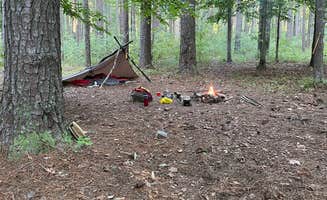Primitive camping near Jacksons' Gap, Alabama offers access points to the Talladega National Forest across varied terrain from 600 to 2,400 feet elevation. The region consists primarily of pine-oak forests with scattered rock outcroppings along ridgelines. The area receives approximately 56 inches of rainfall annually, contributing to seasonal stream variations that impact water availability at many backcountry sites.
What to do
Sunrise photography: Head to the ridge at Skyways Loop Campground with view where campers report excellent visibility. "The only downside I would have to say to staying at this campground is that it has almost no option for filling up water," notes Asher K., suggesting bringing extra water if planning extended stays.
Stream exploration: Multiple water crossings along the trails near Skyway Loop Backcountry Site Near Chinnabee provide cooling spots during warmer months. One reviewer mentions, "The creek runs right alongside so there is easy access to water and it provides a peaceful background sound during the night."
Night sky viewing: Fall and early winter offer clearer skies at higher elevation sites. At Hollins Hunting Camp, Weather Warrior Media reports taking "awesome star pics here" thanks to the open clearing and minimal light pollution from surrounding areas.
What campers like
Trail connectivity: Many backcountry sites sit at trail intersections, providing day-hiking options. At Pinhoti Backcountry Campground near Odum Intersection, Asher K. notes it's "a nice protected area a short way off the trail near the intersection of the Pinhoti and the Odum trail," offering multiple route options.
Protected sites: Rocky formations around some campsites provide natural windbreaks. According to reviews, the Pinhoti Backcountry Campground features "several large boulders that work well to block the wind and make this a more comfortable space in bad weather or when it is cold out."
Low crowd density: Weekday camping particularly at Hollins Hunting Camp often means having areas to yourself. As one camper notes, "Mid-week so no one else here," making it ideal for those seeking solitude.
What you should know
Water sources: Stream-fed water sources require treatment and vary seasonally. At Pinhoti Backcountry Campground near Odum Trail, campers note "water is seasonal and can be very low in winter. Be prepared to not have water for pumping and bring extra in dry times."
Signage limitations: Some trail junctions lack clear markers, particularly during leaf-fall. A reviewer cautions that the Pinhoti Campground North of Talladega Scenic Drive is "easily missed when going along the trail since it requires taking a small path to get to that is overgrown in the summertime."
Camping regulations: Dispersed camping follows standard national forest regulations with 14-day maximum stays. Pack out all trash and use established fire rings only when fire danger is low. Several sites report existing rings that should be used rather than creating new ones.
Tips for camping with families
Distance considerations: For younger hikers, select sites with shorter approaches. Chinnabee Silent Trail Backcountry Site 3 is described as "a nice backcountry campsite a short walk in from the chinnabee silent parking area," making it accessible for families with children.
Group-friendly sites: Some dispersed sites accommodate multiple tents better than others. Ben W. describes Chinnabee Silent Trail Backcountry Site 2 as "a nice open area in a pine thicket, this large site has 2 fire rings and is big enough for even large groups to spread out."
Vehicle access options: For easier gear transport with kids, consider sites with drive-up access. Peyton P. notes about Hollins Hunting Camp: "No marked sites, just pull in and find a spot," which allows families to bring additional comfort items without long hikes.
Tips from RVers
Access limitations: Most dispersed sites near Jacksons' Gap require high-clearance vehicles or hiking. Weather Warrior Media advises about Hollins Hunting Camp: "Overlanders (w/rtt) will be the most happy. Open areas have tall grass a bit, but some have enough pine trees the pine needles make for better ground camping. Small camper trailers could probably make it too. Just be mindful of turn around spots."
Alternative considerations: Traditional campgrounds with facilities might better serve larger RVs. Those with smaller truck campers or vans can access some forest roads, but should scout locations before committing to narrow access points.


